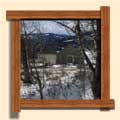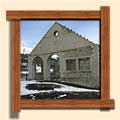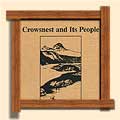


Home>> The Industry>> Mines>> Crowsnest Pass>> Leitch Collieries
 |
|
Bellevue Mine
Blairmore, South Leitch |
|
|
Page 1 | 2 | 3 | 4 | 5 | 6 | 7 | 8 | 9
 An increasing market for coal and coke was rapidly
developing, a market which the Byron creek property could not
handle. As the Leitch Collieries evaluated their holdings they
found there were fourteen seams of high quality coal. There was
room and a flat building surface here for large coke ovens, —
for a coal washing plant to clean and prepare the slack
separated from the coal, for placement in the coke ovens. There
was a limestone cliff, jutting out conveniently close from the
hill, which would provide the quarried rock for building the
ovens, as well as the large power plant, to generate their own
power. All the coal was at a higher level than the projected
tipple site, which would allow for transport by gravity from the
mine mouth to the tipple. The shape of the hill at the projected
tipple site was also perfect for the construction and support of
a large coal holding bin. From here the coal would drop to the
picking table conveyors, for removal of foreign material, on its
way to the box cars on six loading tracks below. As an added
inducement, there was a fifteen foot seam of fireclay lying
above one of the coal seams. This would save considerable
expense in the future, if used on the coke ovens. Last, but by
no means least, much of this coal was royalty free — a very
great bonus. So a decision was made to develop on the Police
Flats.
An increasing market for coal and coke was rapidly
developing, a market which the Byron creek property could not
handle. As the Leitch Collieries evaluated their holdings they
found there were fourteen seams of high quality coal. There was
room and a flat building surface here for large coke ovens, —
for a coal washing plant to clean and prepare the slack
separated from the coal, for placement in the coke ovens. There
was a limestone cliff, jutting out conveniently close from the
hill, which would provide the quarried rock for building the
ovens, as well as the large power plant, to generate their own
power. All the coal was at a higher level than the projected
tipple site, which would allow for transport by gravity from the
mine mouth to the tipple. The shape of the hill at the projected
tipple site was also perfect for the construction and support of
a large coal holding bin. From here the coal would drop to the
picking table conveyors, for removal of foreign material, on its
way to the box cars on six loading tracks below. As an added
inducement, there was a fifteen foot seam of fireclay lying
above one of the coal seams. This would save considerable
expense in the future, if used on the coke ovens. Last, but by
no means least, much of this coal was royalty free — a very
great bonus. So a decision was made to develop on the Police
Flats.
There was a tremendous amount of construction work involved
in doing this. Two long trestles, one ninety, the other one
hundred and ten feet high, had to be built on the haulage route
from the mine head to the tipple. A spur track had to be built to
connect with the C.P.R. main line, so that machinery could be
brought in, as well as coal and coke shipped out later. At first
one and then two engines of their own, were purchased for
handling cars on this track and a one hundred and twenty-five
ton scale on the track for weighing box cars. Two good dynamite
drillers and quarrymen by the name of Barnhill and his
brother-in-law Reid started to quarry rock from the limestone
cliff. Alight track was used to carry the rock to the men
building the coke ovens, and a large building which under one
roof would house a battery of boilers, a generating plant
capable of supplying power for all the equipment, a machine shop
for repairs and fabricating, and an engine house with stalls for
two engines for switching. A bucket conveyor was built to carry
the slack to the one hundred and twenty foot high coal washing
plant. This was filled with large bins and expensive equipment;
experienced men from the States had to be brought in to assemble
it. The slack was dropped from one water vat to another and
finally fed into ten ton trolleys which ran along a track on the
top of the one hundred and one coke ovens, feeding slack into
the top of each oven. Large levelling machines ran along the
side of the ovens on very wide gauge track and levelled the coal
which had been dropped into each oven. Men then bricked up the
doors, so that little air and white hot temperatures could
produce good coke. When this was achieved a large pusher ram,
also on track, emptied the coke out the other door, where it was
rapidly cooled with water hoses and loaded into box cars on a
depressed railway alongside. The inside linings of the ovens
were made of over one million fire and silicon brick imported
from Pennsylvania, as only such quality could withstand the
terrifically high temperatures necessary to produce first
quality coke.
under one
roof would house a battery of boilers, a generating plant
capable of supplying power for all the equipment, a machine shop
for repairs and fabricating, and an engine house with stalls for
two engines for switching. A bucket conveyor was built to carry
the slack to the one hundred and twenty foot high coal washing
plant. This was filled with large bins and expensive equipment;
experienced men from the States had to be brought in to assemble
it. The slack was dropped from one water vat to another and
finally fed into ten ton trolleys which ran along a track on the
top of the one hundred and one coke ovens, feeding slack into
the top of each oven. Large levelling machines ran along the
side of the ovens on very wide gauge track and levelled the coal
which had been dropped into each oven. Men then bricked up the
doors, so that little air and white hot temperatures could
produce good coke. When this was achieved a large pusher ram,
also on track, emptied the coke out the other door, where it was
rapidly cooled with water hoses and loaded into box cars on a
depressed railway alongside. The inside linings of the ovens
were made of over one million fire and silicon brick imported
from Pennsylvania, as only such quality could withstand the
terrifically high temperatures necessary to produce first
quality coke.
There was much ancilliary equipment and buildings, such as
boilers at the mine-head to run a large fan and pumps to keep
the air and water moving in the mine. There was also the
important lamp house where the Wolfe safety lamps were stored
and serviced. They not only lit the way in a mine where there
could be pockets of gas, but acted for the miner like a punch
in, punch out time clock. Each man hung his lamp on his own
special peg when he came off shift. If he was supposed to be
working note would be taken that he was, but if he was due off
shift and hadn't "covered his peg" it was cause for immediate
investigation. Similarly there was the necessary bath house. A
modern installation was a very heavy underground haulage engine,
powered by enclosed electricity, to haul trips to the mouth of
the mine. And there was a large steam hoist and cable to let the
trips of cars run under control by gravity down to the tipple a
mile and a half away, and then haul the empties back. There was
a boarding house capably run by Mrs. Barnhill, a bunk house for singlemen, an assay house, timekeeper's office, horse barns etc.
This article is extracted from Crowsnest and its People: Millennium Edition (Coleman, Alberta, Crowsnest Pass Historical Society, 2000.) The Heritage Community Foundation and the Year of the Coal Miner Consortium would like to thank the authors and the Crowsnest Pass Historical Society for permission to reprint this material.
